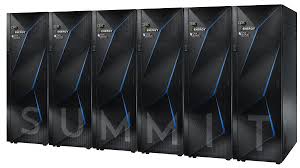 Today the Oak Ridge Leadership Computing Facility (OLCF) announced a significant step forward in the delivery of Summit, the next-generation supercomputer IBM will deliver in 2017 to greatly advance the nation’s energy and science agenda. Following a formal call for proposals and a review process, ORNL revealed 13 science application readiness projects selected as part of the Center for Accelerated Application Readiness (CAAR) program.
Today the Oak Ridge Leadership Computing Facility (OLCF) announced a significant step forward in the delivery of Summit, the next-generation supercomputer IBM will deliver in 2017 to greatly advance the nation’s energy and science agenda. Following a formal call for proposals and a review process, ORNL revealed 13 science application readiness projects selected as part of the Center for Accelerated Application Readiness (CAAR) program.
The CAAR program is focused on optimizing application codes for Summit’s hybrid architecture comprised of IBM POWER CPUs, Nvidia GPU accelerators and the NVLink high-speed interconnect technology, which is expected to provide at least five times the performance of the OLCF’s current leadership system, Titan. Leading up to the delivery of Summit, the CAAR application teams, with technical support from the IBM/NVIDIA Center of Excellence at ORNL, will redesign, port and optimize their software to Summit’s architecture, and demonstrate the effectiveness of their application on Summit through a scientific grand-challenge project.
We know that improved software is just as important as improved hardware to supercomputer performance and our facility’s mission,” says Dr. Tjerk Straatsma, ORNL’s Scientific Computing group leader. “CAAR brings together the people who know the science, the people who know the code, and the people who know the machine, so that cutting-edge science can be conducted on Summit.”
In addition to resources at the OLCF, including Titan and early software development systems for Summit, the CAAR teams will have access to computational resources at the Argonne Leadership Computing Facility (ALCF) and the National Energy Research Supercomputing Center (NERSC) to enable architecture and performance portability across different computing architectures.
These projects were chosen based on a computational and scientific review conducted by the OLCF in consultation with the ALCF, NERSC, IBM and NVIDIA. The application teams represent a broad range of computational algorithms and programming approaches in a diverse range of scientific disciplines including astrophysics, biophysics, chemistry, climate modeling, combustion engineering, materials science, nuclear physics, plasma physics and seismology.
We had a tremendous response to our call for proposals, receiving a large number of strong entries,” Straatsma said. “The diversity of the selected applications gives us the opportunity to develop highly scalable, highly efficient applications for Summit that many of our users can take advantage of when the machine comes into production.”
The modeling and simulation applications selected for the CAAR program and their principal investigators include:
- Climate simulation code ACME, Dr. David Bader, Lawrence Livermore National Laboratory
- Relativistic chemistry code DIRAC, Prof. Lucas Visscher, Free University of Amsterdam
- Astrophysics simulation code FLASH, Dr. Bronson Messer, Oak Ridge National Laboratory
- Plasma physics code GTC, Dr. Zhihong Lin, University of California-Irvine
- Cosmology simulation code HACC, Dr. Salman Habib, Argonne National Laboratory
- Electronic structure application LS-DALTON, Prof. Poul Jørgenson, Aarhus University
- Biophysics simulation code NAMD, Prof. Klaus Schulten, University of Illinois at Urbana-Champaign
- Nuclear physics application NUCCOR, Dr. Gaute Hagen, Oak Ridge National Laboratory
- Computational chemistry code NWCHEM, Dr. Karol Kowalski, Pacific Northwest National Laboratory
- Materials science application QMCPACK, Dr. Paul Kent, Oak Ridge National Laboratory
- Combustion engineering code RAPTOR, Dr. Joseph Oefelein, Sandia National Laboratories
- Seismology application SPECFEM, Prof. Jeroen Tromp, Princeton University
- Plasma physics code XGC, Dr. C.S. Chang, Princeton Plasma Physics Laboratory




